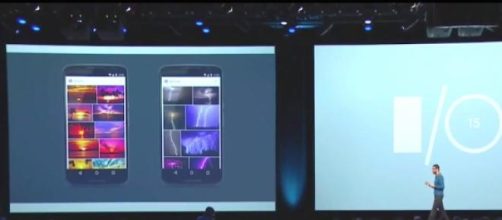There's no escaping Google these days, and the company has just given users a few more incentives to become addicted to it. Several important announcements were made yesterday at its annual I/O developer conference, in San Francisco, which will directly impact how consumers use technology: Google Photos, Jump, Brillo, Now on Tap and Android M. Some took everyone by surprise, as very little had been leaked before the event.
That's not the case of Google Photos, the new standalone app that is attracting the most attention from consumers. Available at photos.google.com, it offers free and unlimited storage for photos and videos, synchronisation with Google Drive, and automatic backups right from the user's camera.
"It's a home for all your photos and videos, available from any device," Photos director Anil Sabharval stated at the opening keynote. The only limit, he added, is the resolution: 16 megapixels for photos and 1080p for videos.
"It's interesting because it is unlimited, it is free, of course a big incentive for users to adopt it," Gartner analyst Mark Hung tells Blasting News. He stressed that the real deal is the "significant artificial intelligence embedded in this application, the fact that it can recognise people through different ages and organise by people, by places, by occasions, without doing any tagging." He considers it pretty impressive, although Apple users were quick to note on social media that a lot of what was demoed is similar to features available on iPhotos for quite some time.
"You will have peace of mind knowing that your photos are safe," Sabharval added, mentioning the automatic backup – which will probably raise security and privacy concerns, as all the pictures will immediately be stored in the cloud. The service became available last night for Android, iOS and web.
New Android
It's dubbed "Android M" and will be out later this year. The current one is "L" and ended up being called Lollipop; after Android KitKat, and should the sweet theme continue, it's not impossible to get something called M&M's, Mars or Maltesers. This next version, 6.0, won't have any revolutionary functionalities. It is focussed on the operating system's stability and performance, to make sure the billions of phones running it deliver a good experience – last year, 8 in every 10 phones sold ran Android, which is why what Google announces matters; it controls 80% of the mobile market.
Among the new things, users will be able to control and revoke app permissions on their phones, an improvement that many had been asking. It will also feature Android Pay, a mobile payment service similar to Apple Pay, with standard support for fingerprint authentication (should the manufacturer choose to include a scan); and improved battery charging and standby times. Dave Burke, vice-president of engineering, called it "the most polished Android release to date." Gartner analyst Van L. Baker agrees, telling Blasting News that "it's an improvement instead of a major jump in terms of functionality," and he didn't expect anything beyond that.
What he was surprised with was with "Now on Tap." Google Now is similar to Apple's Siri and Microsoft's Cortana, but its deep integration with other of the company's apps makes it work differently. What Now on Tap brings is the ability to get answers with a tap on the home button while still using any app and from any screen. Product director Aparna Chennapragada showed how it works by playing a Skrillex song and asking "Ok Google, what's his real name?". The answer came immediately, Sonny John Moore.
"That was probably the most innovative thing here, because it's a much more natural way of interacting with content," Van L. Baker explains. The timing is important, because rumours abound that Apple is working on a rival for Google Now, called Proactive, that will be integrated into the upcoming iOS 9.
Brillo
The market has been buzzing about the Internet of Things (IoT), which will bring connectivity to ordinary appliances around the house, but so far little to nothing happened aside from Nest's thermostats (which Google bought) and smart, expensive lamps. A lot of companies showed off their prototypes at the Consumer Electronis Show, in January, and Apple itself released HomeKit, for developers to work on. So this is where Google Brillo comes in: an operating system for your lamps, doorknobs, and ovens. It's a stripped-down version of Android, meant to power ordinary appliances, allow them to communicate between them and be controlled with Android smartphones. The developer kit will be released on the third quarter and Weave, the communication layer to connect it all, is expected by year's end. Will it make a difference?
"There are still a lot of things missing on IoT, including the use case," analyst Mark Hung dismisses." Brillo is a good addition to helping IoT, but it is definitely not the final puzzle piece."

